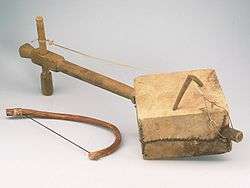Masenqo
The masenqo [Gəˁəz: mäsänqo, መሰንቆ] (also spelled masinqo, mesenqo , mesenko, mesenqo, mesenko, mesinko, or mesinqo in Amharic) or chira-wata (in Tigrinya) is a single-stringed bowed lute commonly found in the musical traditions of Eritrea and Ethiopia.[1] As with the krar, this instrument is used by Ethiopian minstrels called azmaris ("singer" in Amharic) .[2] Although it functions in a purely accompaniment capacity in songs, the masenqo requires considerable virtuosity,[1] as azmaris accompany themselves while singing.
 A traditional Ethiopian masinko or chira-wata | |
| String instrument | |
|---|---|
| Classification | chordophone |
| Hornbostel–Sachs classification | 321.311 (spike bowed lute) |
| Related instruments | |
Construction and design
The square- or diamond-shaped resonator is made of four small wooden boards glued together, then covered with a stretched parchment or rawhide. The single string is typically made of horse hair, and passes over a bridge. The instrument is tuned by means of a large tuning peg to fit the range of the singer's voice.[3] It may be bowed by either the right or left hand, and the non-bow hand sits lightly on top of the upper part of the string.
See also
References
- Shelemay, Kay Kaufman (2001). "Ethiopia". In Sadie, Stanley; Tyrrell, John (eds.). The New Grove Dictionary of Music and Musicians. viii (2nd ed.). London: Macmillan. pp. 355–356.
- Kebede, Ashenafi (January 1975). "The "Azmari", Poet-Musician of Ethiopia". The Musical Quarterly. 61 (1): 47. doi:10.1093/mq/lxi.1.47.
- Teferra, Timkehet (2009). "The One-Stringed Fiddle Masinqo: Its Function and Role in Contemporary Ethiopian Music and its Future". Horizon Ethiopia. Retrieved 12 Sep 2011.